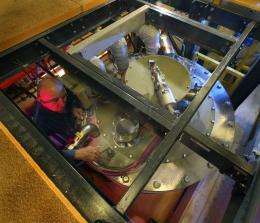High magnetic fields coax new discoveries from topological insulators

(PhysOrg.com) -- Using one of the most powerful magnets in the world, a small group of researchers has successfully isolated signs of electrical current flowing along the surface of a topological insulator, an exotic material with promising electrical properties. The research, led by James Analytis and Ian Fisher of the Stanford Institute of Materials and Energy Sciences, a joint SLAC-Stanford institute, was published Sunday in Nature Physics. The results provide a new window into how current flows in these exotic materials, which conduct current with almost no resistance along the exterior, while acting as insulators at the interior. At least in theory.
"This is a difficulty people in the field have been struggling with for two years," Fisher said. "The topological part is there but the insulator part isn't there yet." Chemical imperfections in the materials being tested have meant that the interior, or bulk, portions of topological insulators have been behaving more like metals than insulators.
In other words, while researchers have been trying to decipher the behavior of the electrons on the surface by observing the way they conduct current (called electronic transport), the electrons in the interior have also been conducting current. The difficulty arises in telling the two currents apart.
But, according to Fisher, the promise of useful applications for these exotic new materials—not to mention possible discoveries of fundamental new physics—rests on the ability to measure and control the electric current at the surface. In order to do so, Analytis, Fisher, and their group first had to reduce the amount of current running through the bulk of the material until the surface current could be detected, and then probe the physical properties of the electrons responsible for that surface current.
Analytis tackled the first problem by replacing some of the bismuth in bismuth selenide, a known topological insulator, with antimony, a lighter relative with the same number of electrons in its valence, or chemically reactive, shell. This provided a way to reduce the number of charge-carrying electrons in the interior of the sample.
But even after removing hundreds of billions of electrons, "we still didn't have an insulator," Analytis said. That's when he turned to Ross McDonald and the pulsed magnets at the Pulsed Field Facility, Los Alamos National Laboratory's branch of the National High Magnetic Field Laboratory.
Electrons in a uniform magnetic field follow circular orbits. As the electrons are subjected to higher and higher magnetic fields, they travel in tighter and tighter orbits, which are quantized, or separated into discrete energy levels, called Landau levels. Using a high-enough magnetic field to trap the bulk electrons in their lowest Landau level enabled Analytis to differentiate between the bulk electrons and the surface electrons, or, as Fisher put it, "get the bulk under control."
With McDonald's help, Analytis used one of Los Alamos' multi-shot pulsed magnets, so called because they deliver their full field strength in pulses lasting thousandths of a second. Analytis discovered that a moderate field of four Tesla (about twenty thousand times the strength of a refrigerator magnet) was sufficient to force the bulk conduction electrons into their lowest Landau level. Then he pushed the magnetic field to 65T to see what the surface electrons on the topological insulator would do.
He saw a clear signature from the Landau levels of the surface electrons. And, at the very highest magnetic fields, at which the surface electrons are pushed most closely together, Analytis detected signs that the electrons interacted with each other, instead of behaving like independent particles.
"It's beautiful," Fisher said. "It's unambiguous evidence that we can probe electronic transport in the surface of these materials." However, much of the difficulty in creating a truly insulating topological insulator remains.
"It feels like we've opened a door to the place [experimenters] want to be," he said, "but there's a lot more work to be done."
In the meantime, Analytis is moving ahead with his latest experiment—hitting the antimony-doped bismuth selenide with a staggering 85T—the highest magnetic field available in a multi-shot magnet anywhere in the world.
More information: Paper online: www.nature.com/nphys/journal/v … /full/nphys1861.html
Provided by SLAC National Accelerator Laboratory




















